When I added Japanese inspired decor to my living room, it changed everything. The simple look and natural touches brought a calm I’d never felt before. It made my room feel truly unique.
Many people love this style for its ability to make spaces peaceful and welcoming. In this article, we’ll look at 12 decor ideas to make your home a tranquil retreat.
We’ll cover everything from beautiful lighting to key design principles. You’ll learn how to bring japanese home decor ideas into your home and make it special.
Understanding Japanese Home Decor Aesthetic
Japanese interior design is more than a style; it’s a way to make a peaceful space. It’s about simplicity, connecting with nature, and finding balance in every part of the home.
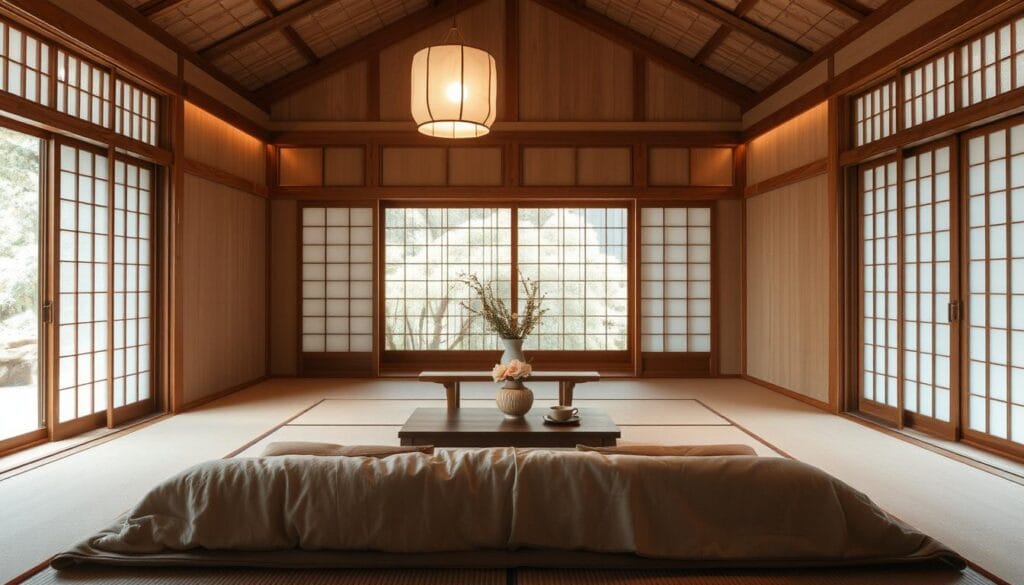
Principles of Minimalism
Minimalism is a key part of Japanese home decor. It means reducing clutter and focusing on what’s essential. This creates a calm and serene atmosphere.
To get a minimalist Japanese look, try these tips:
- Choose multi-functional furniture to cut down on clutter
- Stick to a simple color scheme for unity
- Use empty space to make your room feel open
Emphasis on Nature
Nature is very important in Japanese culture. It’s reflected in the use of natural elements in home decor. Adding wood, stone, and plants brings the outdoors in.
Here are some ways to add nature to your home:
- Use natural materials for furniture and decor
- Add plants and greenery to your space
- Let in natural light with sheer curtains or blinds
Balance and Harmony
Balance and harmony are key in Japanese home decor. It’s about finding a balance between different things, like light and dark, and nature and man-made items.
To achieve balance, think about yin and yang. This idea shows how opposites are connected. By balancing these opposites, you can create a peaceful and harmonious space.
Key Elements of Japanese Decor
Creating a Japanese-inspired home is more than just looks. It’s about simplicity and harmony with nature. You’ll learn how to bring peace and balance to your space.
Wood and Natural Materials
Wood is a big part of Japanese decor. It’s used for floors, furniture, and decorations. The warmth and texture of wood make your home feel cozy and welcoming.
Bamboo, rattan, and stone are also used. They add beauty and calm to your space.

Neutral Color Palettes
Neutral colors like white, beige, and gray are key in Japanese decor. This minimalist color scheme lets the beauty of materials and design shine.
Subtle textures and shading add depth. But the overall look stays calm and serene.
Paper Screens and Shoji
Paper screens and shoji are common in Japanese homes. These translucent panels soften the light, making your space feel peaceful.
Shoji screens can divide spaces or act as room dividers. They offer privacy while keeping things open. Their simplicity and beauty are essential for a modern Japanese home.
Incorporating Zen Principles
Adding Zen principles to your home decor is more than a design choice. It’s a way to make your living space more mindful and peaceful. By embracing simplicity and tranquility, you can turn your home into a calm oasis. This oasis encourages relaxation and mindfulness.
Creating Tranquility
To create a peaceful home, focus on Japanese style interior design. Use natural materials, reduce clutter, and add elements of nature. For example, a small indoor Zen garden can bring calm to your space. You can find zen garden ideas for small spaces online.
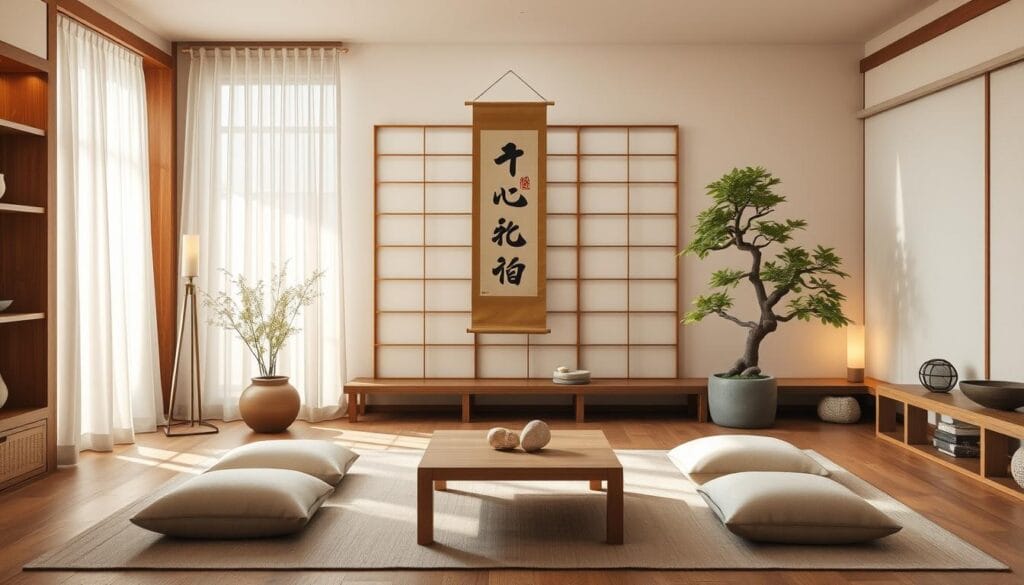
To enhance tranquility, use soft, ambient lighting and place decorative items thoughtfully. Aim for a calm, uncluttered space. This allows you to relax and unwind.
Mindful Arrangements
Mindful arrangements are crucial in minimalist Japanese interior design. Place furniture and decorative items with care to achieve balance and harmony. Each element should have a purpose or bring joy.
When arranging your space, focus on balance and harmony. Create a focal point and balance it with other elements. For instance, a beautiful artwork or vase can be the focal point, surrounded by simple decor.
The Art of Simplicity
The art of simplicity is central to Zen home decor. It’s about removing the unnecessary and embracing simplicity’s beauty. Your space doesn’t have to lack character; each element should be meaningful and contribute to serenity.
To practice simplicity, declutter your space and remove items that don’t serve a purpose or bring joy. Then, choose a few decorative pieces that reflect your style and enhance the tranquil atmosphere.
By applying Zen principles to your home decor, you can create a space that’s not just beautiful but also peaceful and mindful. Whether you prefer minimalist Japanese design or Zen decor, the goal is to make a space that feels authentic and serene to you.
Furniture Choices for Japanese Interiors
Creating a serene Japanese-style home needs careful furniture choices. The right pieces can make your space tranquil and functional. They reflect Japanese design’s core principles.

Low-Maintenance Solutions
Japanese design values simplicity and easy upkeep. Choose low-maintenance materials and designs for your furniture. Natural wood or bamboo furniture adds warmth and is easy to care for.
Some great low-maintenance furniture ideas are:
- Platform beds with storage
- Simple, sleek coffee tables made from natural materials
- Minimalist shelving units
Multi-Functional Pieces
Japanese homes use multi-functional furniture to save space and be efficient. These pieces are practical and keep the space uncluttered, a key feature of Japanese interiors.
Examples of multi-functional furniture are:
- Sofa beds
- Storage ottomans
- Tables with built-in storage
Contemporary vs. Traditional Styles
Japanese furniture beautifully combines contemporary and traditional styles. Traditional Japanese furniture uses natural materials and focuses on function. Contemporary pieces may use modern materials but keep traditional aesthetics.
Mixing traditional and modern pieces creates a balanced look. For example, a traditional tatami mat with modern furniture can make a unique space.
Accessorizing with Japanese Crafts
Adding Japanese crafts to your home brings character and warmth. These crafts are not only beautiful but also carry a deep history and culture. They are perfect for adding a unique touch to your space.

Ceramics and Pottery
Ceramics and pottery are key in Japanese decor, known for their simplicity and elegance. They can be decorative or functional, like vases or tea sets. Look for pieces that show Japan’s natural beauty, like subtle glazes or traditional designs.
To add ceramics and pottery to your decor, display them on a shelf or as centerpieces. This adds visual interest and brings Japanese decor inspiration to your space.
Textiles and Fabrics
Textiles are crucial in Japanese interior design, with fabrics like silk, cotton, and linen used for beautiful pieces. From kimonos to throw pillows, Japanese textiles add warmth and texture to any room.
Choose natural materials and subtle patterns for your textiles. These should reflect the understated elegance of Asian home decor ideas. Use these fabrics to enhance furniture, like reupholstering a chair or making a throw blanket.
Ikebana: The Art of Flower Arrangement
Ikebana, the traditional Japanese flower arrangement, brings nature indoors. It emphasizes harmony, balance, and simplicity, fitting well with Japanese style interior design.
To practice Ikebana at home, start with simple arrangements using seasonal flowers and branches. Aim for balance and harmony, and experiment with shapes and textures. This will beautify your space and offer a meditative experience.
By adding these Japanese crafts to your home, you create a space that’s beautiful and rich in culture and tranquility. Whether you want to make a bold statement or add a subtle touch, Japanese crafts offer endless possibilities for enhancing your decor.
Japanese Garden Inspirations
Adding Japanese garden elements to your home can change your space. It brings calm and serenity. Japanese gardens help you connect with nature and be mindful. By bringing these elements inside, you can make a peaceful spot in your home.
Indoor Zen Gardens
An indoor Zen garden can bring tranquility to your home. These gardens use sand, stones, and plants to create calm. Start with a shallow container, add sand or gravel, and stones for patterns. Small plants like moss or succulents add texture and interest.
Indoor Zen gardens help you relax and feel better. Place them in quiet spots, like a meditation room or reading nook. This makes your home more peaceful.

Bonsai Trees
Bonsai trees are a key part of Japanese gardens. They are small, trained trees that add beauty to any room. Choose a bonsai that fits your home’s environment and care for it regularly.
Bonsai trees bring harmony to your home. They look great with stones or water features. Display them in places like living rooms or entryways.
Using Stones and Gravel
Stones and gravel are vital in Japanese gardens. They add texture and interest to your decor. Stones can mark paths or define areas. Gravel creates calm and can cover large spaces or make patterns.
Use stones and gravel in bowls, vases, or as plant toppings. They can also make a Zen garden or add interest to big spaces.
These Japanese garden elements can make your home peaceful and calming. They promote relaxation and mindfulness. Whether you want azen home decoror just somejapanese inspired decor, these elements help achieve aminimalist japanese interior design.
Lighting Considerations in Japanese Decor
Exploring Japanese decor, I see how lighting is key. It sets the mood for a calm and welcoming home. The right lights can make a space feel cozy and inviting.
Japanese lighting is all about creating calm. This is done with soft, ambient lighting. You can use many types of fixtures to achieve this.
Soft, Ambient Lighting
Soft, ambient lighting is a must in Japanese decor. It makes a space feel peaceful, perfect for unwinding. To get this look, try:
- Table lamps with soft shades
- Floor lamps with ambient lighting
- String lights for a cozy glow
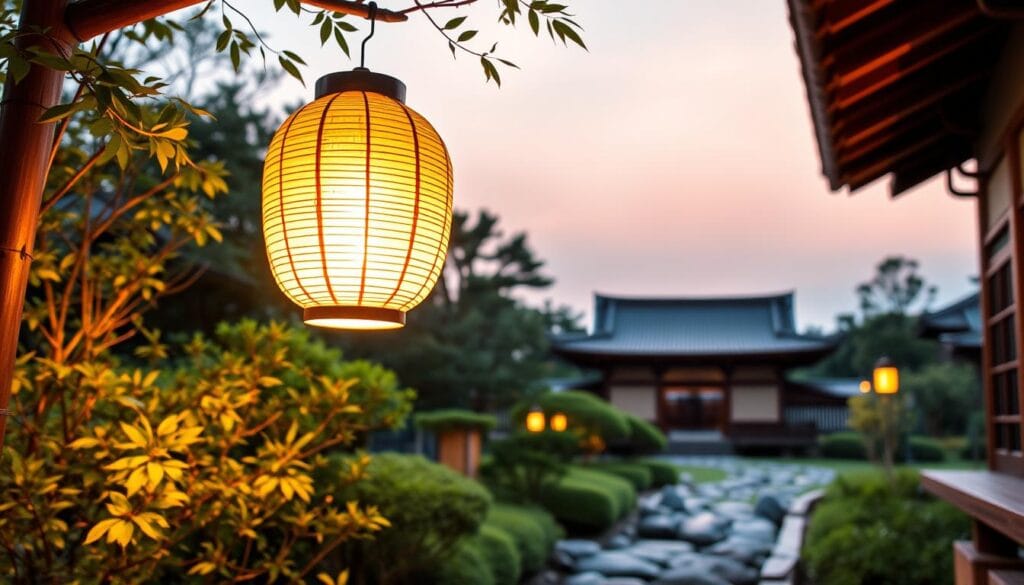
Lanterns and Paper Lamps
Lanterns and paper lamps are key in Japanese lighting. They bring traditional charm and a warm glow. You can find:
- Traditional Japanese lanterns
- Paper lamps with natural linen shades
- Modern lanterns with a Japanese twist
These lights do more than just light up your space. They also decorate, adding to your Japanese decor inspiration.
Natural Light Enhancement
Japanese decor also values natural light enhancement. Using natural light makes a space brighter and more welcoming. To do this, try:
- Using sheer curtains or blinds to filter the light
- Placing mirrors opposite windows to reflect natural light
- Keeping windows unobstructed to allow for maximum sunlight
By using these tips, you can make a modern Japanese home that’s bright, airy, and peaceful.
Color Schemes in Japanese Interiors
Japanese interior design is known for its careful color choices. These colors help create a peaceful atmosphere.
The colors used in Japanese interiors aim to bring calm and serenity. They draw inspiration from nature and the minimalist style.
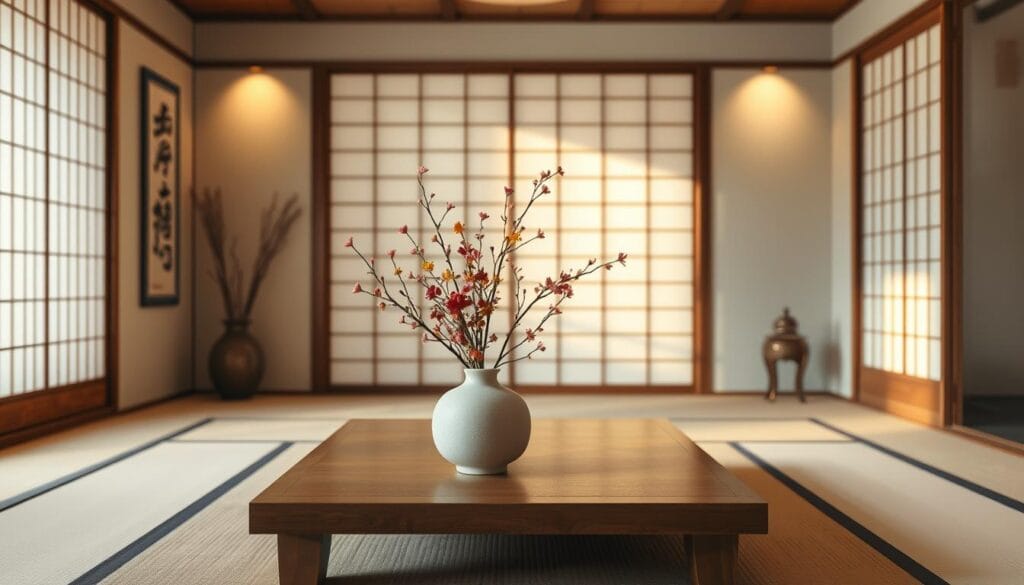
Earthy Tones and Neutrals
In traditional Japanese interior design, earthy tones and neutrals are key. Shades of brown, beige, and taupe create a cozy, natural feel.
- Beige and off-white shades reflect Japanese design’s simplicity and elegance.
- Various browns add warmth and coziness.
- Taupe and muted tones bring balance and harmony.
Accent Colors: Blue and Green
While neutrals are the base, Japanese style interior design uses accent colors for depth. Blues and greens are favorites, as they remind us of nature. They can be soft or vibrant.
- Soft blues create a calming, serene feel.
- Greens, from light sage to deep forest, bring nature indoors.
The Impact of Color Psychology
The choice of colors in traditional Japanese interior design goes beyond looks. It’s also about the psychological effects. Earthy tones offer stability and comfort. Blues and greens promote calmness and renewal.
Choosing colors that follow Japanese design principles can make your space beautiful and peaceful. It can also improve your well-being and serenity.
Art and Wall Decor Ideas
Japanese interiors are famous for their careful use of art and decor. This makes any space feel like a peaceful retreat. Art and decor not only make a room look better but also change its feel.
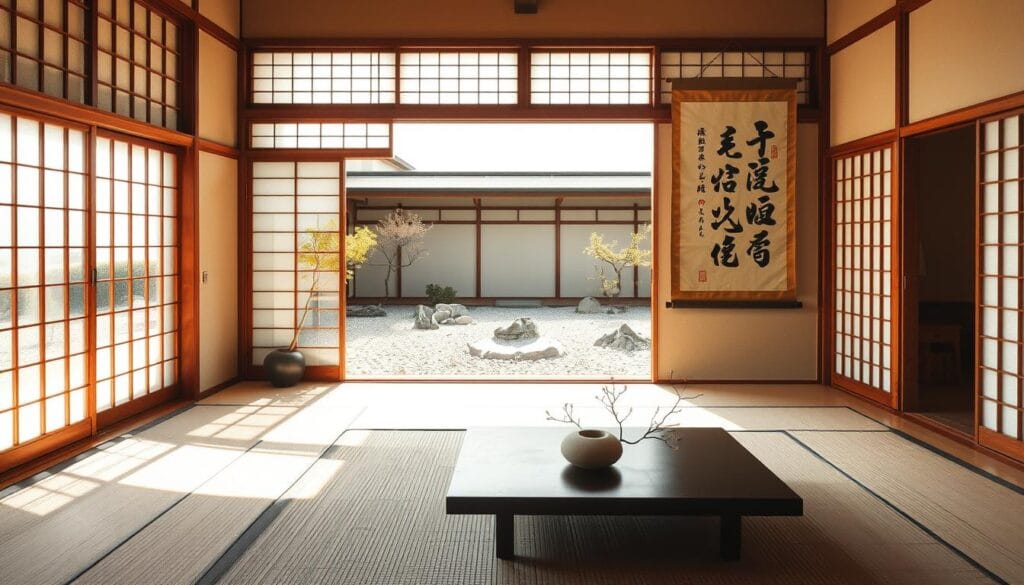
Traditional Japanese Prints
Traditional Japanese prints, like Ukiyo-e woodblock prints, are a big part of Japanese decor. They show natural scenes, landscapes, or everyday life. This adds cultural depth and beauty to a room.
To add traditional Japanese prints to your decor, use simple frames. Choose frames that match the print’s colors and style. This lets the art stand out while keeping the room calm and serene.
Modern Art Integration
Modern art can also be part of Japanese decor, adding a fresh twist. Look for pieces that share Japanese values like simplicity and calmness. Abstract art that feels peaceful can also work well.
When picking modern art for your Japanese-style home, focus on natural materials. Choose art that feels calm and simple. Mixing old and new art creates a unique and interesting space.
The Use of Calligraphy
Calligraphy is a big part of Japanese art and decor. It adds elegance and cultural depth to a room. A piece of calligraphy can be a focal point, adding interest and depth.
To use calligraphy in your decor, think about where to place it. A big piece can be a statement wall. Smaller works can be grouped for a nice display. The goal is to balance calligraphy with other decor to keep the room harmonious.
Kitchen and Dining in Japanese Homes
Creating a kitchen and dining area inspired by Japanese design can make your dining experience better. In Japanese homes, these spaces are more than just places to eat. They are about creating a peaceful and harmonious environment that encourages connection and mindfulness.
Open Shelving and Simplicity
Japanese style interior design focuses on simplicity and openness. In the kitchen, open shelving is key. It provides storage and keeps the space airy and clutter-free. Displaying dishes and cookware on open shelves adds to the calm and makes the space feel bigger.

Use of Natural Materials
Natural materials are essential in Japanese kitchen and dining design. Wood, stone, and paper products add warmth and texture. For example, a wooden kitchen island or a stone countertop can bring the outdoors in, making your kitchen feel more welcoming.
Incorporating Zen Dining Experience
To bring a zen home decor ideas experience to your dining area, focus on mindfulness and tranquility. Use low-seating furniture, add plants or a water feature, and ensure soft, ambient lighting. The goal is to create a space that encourages you to slow down and enjoy the moment.
Here are some tips for a Zen dining experience:
- Use natural textiles for table runners and placemats
- Add natural elements, like a vase with branches or a bowl of river rocks
- Keep the dining area clutter-free and organized
By following minimalist Japanese interior design principles in your kitchen and dining area, you can create a space that is not only beautiful but also deepens your connection to food and loved ones.
Bathrooms with a Japanese Touch
To create a calming bathroom, look to Japanese design. It focuses on simplicity, natural elements, and peace. These elements make for a serene bathroom retreat.
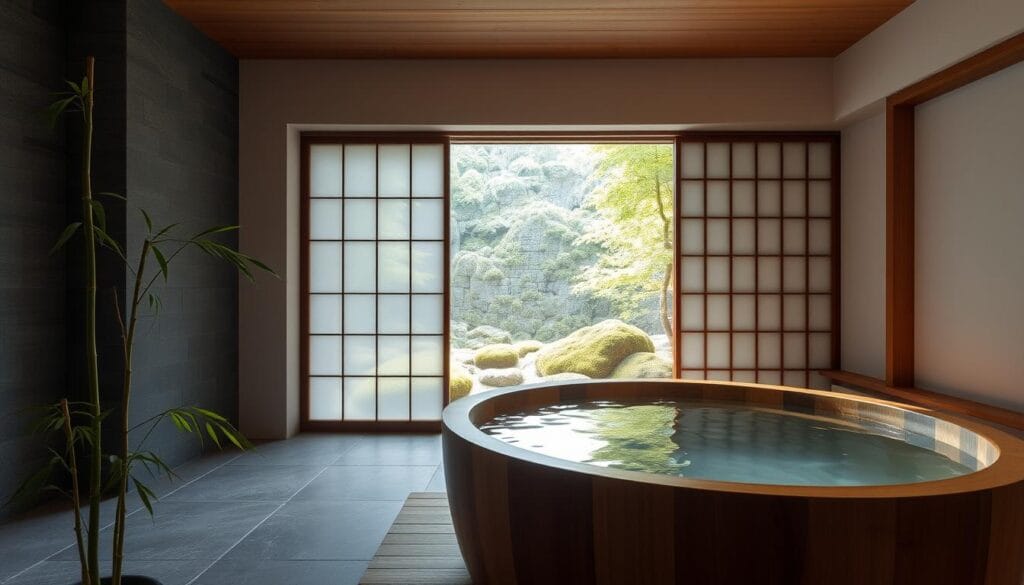
Soaking Tubs and Outdoor Baths
Soaking tubs, or ofuro, are key in Japanese bathrooms. They’re deep and made for relaxation. For a luxury touch, add an outdoor bath with wood and stone.
- Choose a tub from natural materials like cedar or stone.
- Add a small garden or water feature near your bath.
- Use privacy screens or natural barriers for a secluded spot.
Natural Textiles in Decor
Natural textiles are vital in Japanese decor. They add warmth and coziness. Think about bamboo blinds, woven baskets, or natural fiber rugs.
Some popular natural textiles for bathrooms include:
- Bamboo
- Woven reeds
- Natural cotton or linen
The Importance of Cleanliness and Order
Cleanliness and order are key in Japanese culture, even in the bathroom. A clutter-free, clean space is crucial for peace.
Practical tips for maintaining cleanliness and order:
- Regularly clean your bathroom, focusing on soap scum and water spots.
- Use baskets or cabinets for toiletries and towels.
- Keep clutter down by limiting displayed items.
Creating a Relaxing Meditation Space
A serene meditation space can be a sanctuary, offering a peaceful escape from daily life. By adding Japanese inspired decor and minimalist Japanese interior design, you can make a calm atmosphere. This atmosphere supports mindfulness and relaxation.
A Corner of Stillness
Having a specific area for meditation is key. This corner of stillness should be free from distractions and clutter. It helps you focus on your practice. Choose a quiet corner or secluded spot in your home and add elements that promote calm.
Use of Natural Elements
Using natural elements is a core part of zen home decor ideas. Materials like wood, stone, and plants bring the outdoors in. For instance, a wooden floor or a stone statue can add warmth and texture. Plants like bamboo or bonsai trees also enhance the natural feel.
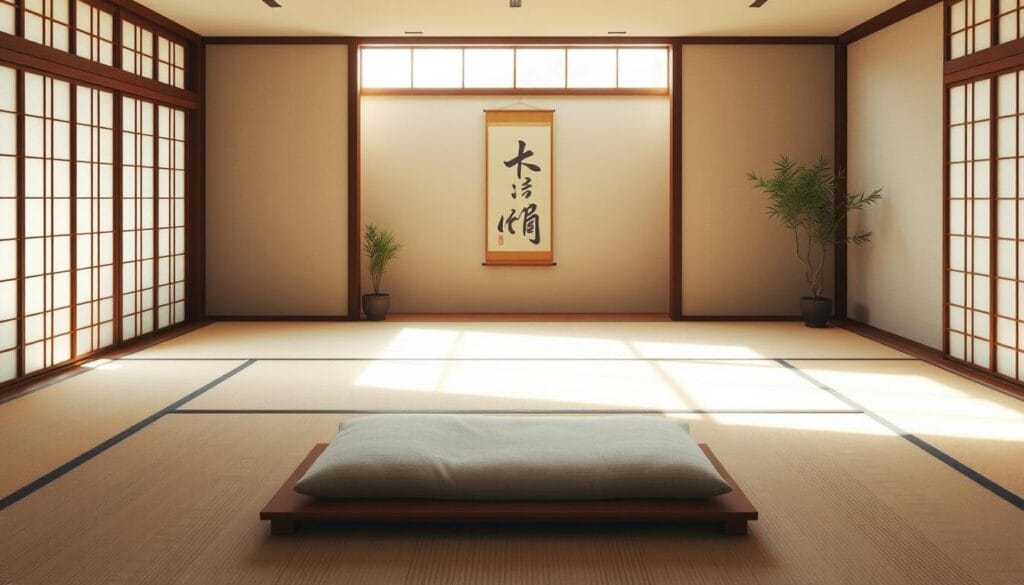
For more ideas on creating a Japandi meditation space, check out this guide on Japandi decor. It shares insights on mixing Japanese and Scandinavian design for a mindful lifestyle.
Importance of Silence
Silence is crucial in a meditation space. It’s important to keep noise levels low and encourage quiet thought. Use sound-absorbing materials like thick rugs or soundproofing panels. Also, place your meditation space away from noisy areas.
Designing your meditation space with these elements in mind creates a haven. It nurtures your mind, body, and spirit. Whether you want to improve your mindfulness or find a peaceful retreat, a well-designed meditation space is a great addition to your home.
Combining Japanese Decor with Modern Styles
Mixing Japanese decor with modern styles is an exciting journey. It leads to a serene and stylish living space. This blend allows us to create a unique home that shows our individuality.
One key aspect is making eclectic mixes. We can mix traditional Japanese elements like tatami mats and shoji screens with modern furniture. This creates a fascinating contrast that adds depth to our spaces.
Eclectic Mixes
Eclectic mixes let us play with different textures, colors, and shapes. For example, pairing a minimalist sofa with a traditional Japanese low-seating table is captivating. It creates a visual dynamic.
- Combine natural materials like wood and bamboo with modern metallic accents.
- Use traditional Japanese motifs, such as cherry blossoms, in modern contexts like throw pillows or wall art.
- Incorporate vintage Japanese pieces into a contemporary setting for added character.
Successful Blending Techniques
To blend Japanese decor with modern styles, finding a balance is key. We need to understand Japanese style interior design and apply it in a way that complements modern aesthetics.
Some successful techniques include:
- Maintaining a neutral color palette to provide a calm backdrop for eclectic decor.
- Using natural light to enhance the sense of space and serenity.
- Incorporating plants and greenery to bring in a touch of nature.
Case Studies of Interiors
Let’s explore some inspiring examples of Japanese decor inspiration in modern homes. These examples show how blending traditional and contemporary elements can create beautiful, functional spaces.
For instance, a modern Japanese home might have a traditional tatami room next to a sleek, modern kitchen. The contrast between these areas is visually interesting and harmonious.
By embracing the fusion of Japanese decor and modern styles, we can make homes that are both beautiful and deeply personal. These homes reflect our values and individuality.
Final Thoughts on Implementing Japanese Decor
Incorporating Japanese home decor ideas can turn your living space into a peaceful oasis. Focus on making your space unique by choosing items that speak to you.
Personalizing Your Space
Begin with natural materials and neutral colors, key elements of Japanese decor. Add a special piece, like a bonsai tree or a handmade vase, to make your space unique.
Practical Tips for Integration
Start small when adding Japanese decor to your home. Try replacing heavy curtains with shoji screens or adding Zen-inspired art. These changes can greatly improve your space’s feel.
Encouraging Mindfulness at Home
Japanese decor is more than looks; it’s about mindfulness. Creating a calm space helps you relax and think deeply. As you add Japanese and Zen decor to your home, enjoy the beauty in everyday things.
